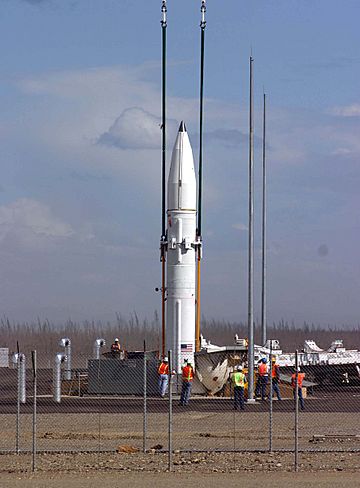Fort Greely facts for kids
Fort Greely is a special place in Alaska. It is a United States Army base. It's used to launch anti-ballistic missiles. These missiles are designed to stop other missiles in the sky. Fort Greely is about 100 miles (160 km) southeast of Fairbanks.
This base is also home to the Cold Regions Test Center (CRTC). Fort Greely is one of the coldest places in Alaska. This makes it perfect for testing military equipment. They test how well things work in cold, very cold, and even mild weather. The base is named after Major General Adolphus Greely. There was also an older Fort Greely on Kodiak Island.
Contents
History of Fort Greely
How it Started
The base began in 1942. It was first called Big Delta Army Air Field. During World War II, a big road was built. This road was the Alaska Highway. It connected Canada to Alaska. The highway met the Richardson Highway near Fort Greely.
The United States used this base during the war. They sent airplanes and supplies to the Soviet Union. This helped the Soviets fight Germany and Japan. This was part of the Lend-Lease program. Later, the base was renamed Allen Army Airfield. After the war, Fort Greely was built near the airfield.
Testing in the Cold
After World War II, the Army wanted to know something important. They wanted to know if American soldiers could fight in any cold weather. So, they sent groups called "Task Forces" to Alaska. These groups tested Army equipment in the cold. Task Force Frigid and Task Force Williwaw went to Alaska in 1946 and 1947.
These early tests helped a lot. But it was hard to move people and gear for short tests. It was also expensive. The Army decided it needed a permanent test place. This would help them learn more about cold weather operations.
A Permanent Test Center
In 1949, the Army created the Arctic Test Branch. It was at Big Delta Air Force Base. This base is now Fort Greely. The first team for this new center came from Kentucky. They moved to Alaska in July 1949. Soon after, it was called the Arctic Training Center. In 1957, it became the U.S. Army Arctic Test Board. Its job was to test all Army equipment in Arctic conditions.
From 1955, Fort Greely became a big training area. Soldiers learned to fight in cold weather. This was important during the Cold War. The Cold War was a long period of tension with the former Soviet Union.
In the early 1960s, the Army built a special power plant. It was a nuclear power plant called SM-1A. It helped provide electricity to the base. This plant worked until 1972.
In 1962, the Arctic Test Board changed again. It became the Arctic Test Center. It grew bigger and took over other test groups. In 1976, it was renamed the U.S. Army Cold Regions Test Center. This is the CRTC we know today.
Fort Greely Today
The Cold War ended in 1991. The number of soldiers at Fort Greely became smaller. In 1995, there were plans to reduce operations even more. Only the Cold Regions Test Center (CRTC) was supposed to stay. But these plans changed.
In 2001, the main offices for the Northern Warfare Training Center and CRTC moved. They went to Fort Wainwright. Some training areas also moved. But CRTC still kept testing at Fort Greely.
After 2002, Fort Greely became very important. The United States decided to build a missile defense system. This system is called Ground-Based Midcourse Defense. Fort Greely was chosen as a key site. Workers began building missile defense facilities there. They planned to have many anti-ballistic missiles by 2010.
In 2005, the CRTC headquarters moved back to Fort Greely. In 2014, Congress approved money to add more interceptor missiles. The number of missiles at Fort Greely increased from 26 to 40.
Protecting Against Missiles
North Korea has been developing its own long-range missiles. These are called intercontinental ballistic missiles. Because of this, Fort Greely might expand even more.
Fort Greely is one of only two places in the U.S. with anti-ballistic missile interceptors. It is also located on a direct path from North Korea to the United States. This makes it a very important place. It helps protect Alaska and the West Coast of the United States from possible missile attacks.


